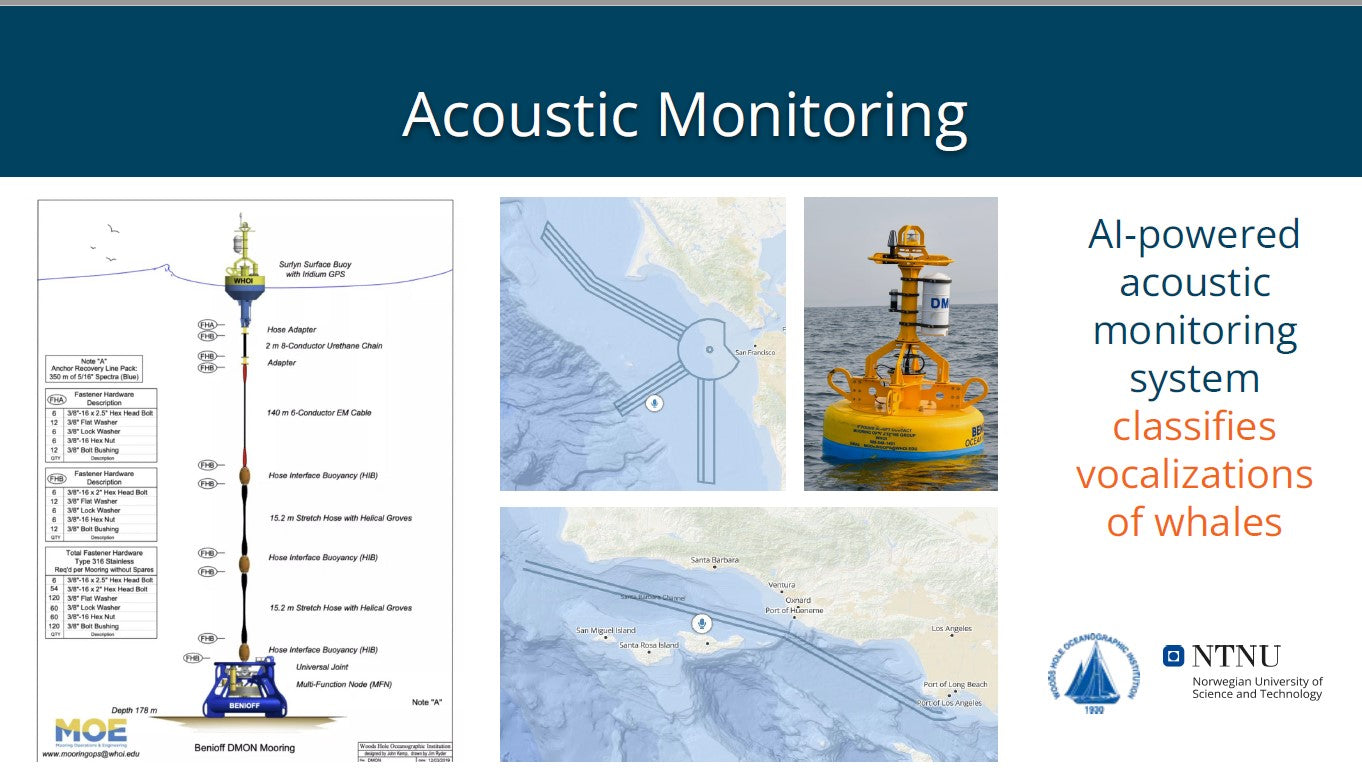Whales are majestic creatures that roam the vast ocean waters, but their existence is threatened by human activity.

One of the major threats is from ship strikes, which can be fatal to whales. To help protect these gentle giants, the University of California Santa Barbara’s Benioff Ocean Initiative is working with leading whale scientists from Woods Hole Oceanographic Institution, Norwegian University of Science and Technology, the University of California Santa Cruz, University of Washington, NOAA’s Southwest Fisheries Science Center, Conserve IO, The Marine Mammal Center, Point Blue Conservation Science, and Cascadia Research Collective to track whale and shipping activity to provide the best available science to reduce the risk of whale-ship collision through a tool called Whale Safe. It is a system that uses acoustic modeling, blue whale modeling, and sighting data to predict daily whale presence ratings and more.
How Whale Safe Works
The Whale Safe system is built on the premise that whales communicate with each other using low-frequency sounds. These sounds can be detected and analyzed using underwater microphones called hydrophones. The Whale Safe system uses hydrophones deployed at various locations in the ocean to capture these sounds.
The acoustic data collected by the hydrophones is analyzed using advanced machine learning algorithms to identify and classify the sounds. Passive acoustic monitoring has become increasingly popular for assessing marine mammal occurrence and distribution. However, the large volume of acoustic data and the laborious task of manually analyzing this data has hindered its broad application. To address this issue, a generalized automated detection and classification system (DCS) has been developed to efficiently and accurately identify low-frequency baleen whale calls.
The system uses a combination of acoustic modeling and blue whale modeling to identify the different types of whale sounds and determine their locations. Dr. Elliott Hazen and Dr. Briana Abrahms have worked with a team of researchers from various universities and the National Oceanic and Atmospheric Administration (NOAA) to create a computer model that predicts where blue whales are likely to be found on a daily basis. This model uses information about the data to make these predictions.
The Whale Safe system also incorporates sighting data from the Channel Islands Naturalist Corps, Point Blue Conservation Science researchers, The Marine Mammal Center, and trusted observers on whale watch vessels. They utilize the Whale Alert and Spotter Pro mobile apps to capture these sightings. In addition, they receive monthly aerial monitoring data from the Channel Islands National Marine Sanctuary staff, and ship-based surveys specifically for the Santa Barbara Channel shipping lanes. Their comprehensive approach to data collection ensures that they have the most up-to-date information to provide alerts to the shipping industry and boaters, helping to keep these magnificent creatures safe. The sighting data is used to validate the presence of whales and to further refine the predictions in the area and to help the system learn and adapt to changing conditions.
Daily Whale Presence Ratings and Alerts
Using the data collected from the hydrophones and the sighting data, the Whale Safe system generates daily whale presence ratings. These ratings are used to provide alerts to the shipping industry and boaters about the presence of whales in their vicinity.
The alerts are sent out via various channels, including Twitter, emails, and APIs. The alerts provide information on the location and number of whales present, as well as advice on how to avoid them. For example, the alerts may advise ships to reduce their speed or change their course to avoid collisions with the whales.
The Impact of Whale Safe
Since its inception, Whale Safe has had a significant impact in reducing the number of ship strikes on whales. The system has been adopted by the shipping industry and boaters, who use the alerts to avoid collisions with whales.
The system has also contributed to the conservation efforts of endangered whale species. The Whale Safe system has helped to reduce the number of ship strikes, which is vital for their survival.
In Conclusion
Whale Safe is an excellent example of how technology can be used to protect endangered species. By using acoustic modeling, blue whale modeling, and sighting data, the Whale Safe system can predict daily whale presence ratings and provide alerts to the shipping industry and boaters about the presence of whales. The system has had a significant impact in reducing the number of ship strikes on whales, and it has contributed to the conservation efforts of endangered whale species. The Whale Safe system is a powerful tool for protecting these gentle giants and ensuring their survival for future generations.



Share:
Unlocking the Hidden Benefits of Scuba or Freedive Training at Local Dive Store
Discovering the Majestic Whales and Dolphins of Southern California Bight: A Journey into the Depths of the Pacific